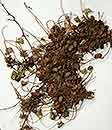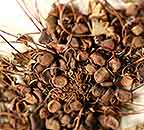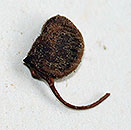Marsilea farinosa Launert ssp. farinosa
Synonyms |
|
|---|---|
Common name |
|
Description |
Rhizome rather stout, up to 2.5 mm in diameter, silvery-grey or brown, with hairs or hairless; internodes usually very short, rarely up to 5 cm. Floating form: stipe up to 20 cm long. Leaflets up to 10-21 × 11-22 mm, broadly obdeltate, almost hairless, outer margin rounded, wavy. Dry land form: stipe up to 12 cm long, with bristly hairs. Leaflets up to 4-15 × 3-15 mm, obdeltate, set with a mixture of hairs, becoming subglabrous with age, outer margins lobed. Sporocarps: in clusters at the base of the stipe, bean-shaped, 4.2-7 mm long, 2.5-4.5 mm high, 1.5-2.3 mm thick, upper side straight or concave, under and outer side rounded, vertical cross-section rectangular; lateral ribs 8-11, not conspicuous in mature specimens; raphe present, extending 1/2–2/3 the length of the base of the sporocarp; veins (as seen on the interior surface) not anastomosing; lower tooth absent or very shallow hump, upper tooth present but usually rather inconspicuous, sharply obtuse to acute. Sporocarp densely covered with hairs of 2 kinds, erect and flattened, which in the dried state cause the powdery greyish appearance of the sporocarp. Sporocarps set at an angle of 90° to the pedicel; pedicels 8-15 mm, erect or arching, free, relatively slender, flexible, (4–)8–15(–25) mm long, arising from the axil of the stipe, with bristly hairs. Sori 8–11. |
Notes | It differs from other species by its hispid appearance created by the 2 kinds of hairs. |
Derivation | farinosa: powdery or with meal-like covering, alluding to the greyish appearance created by the hairs that cover much of the plant. |
Habitat | Woodland and dry woodland savanne in dry, sandy riverbeds and seasonal vleis and pans. |
Distribution worldwide | See African distribution. |
Distribution in Africa |
Angola, Botswana, Ethiopia, Kenya, Mozambique, Namibia, South Africa, Tanzania , Zimbabwe. |
Growth form |
Aquatic, terrestrial. |
Literature |
|


